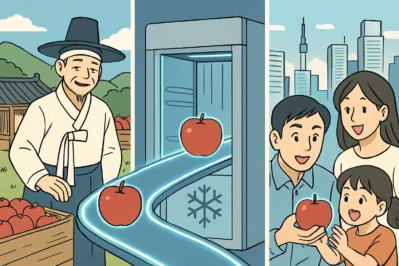Beyond the Harvest: Korea’s Tech War on Food Waste
Hello! It’s your favorite Korean language guide, [Maeil Hangeul], here to upgrade your Korean skills to the next level!
Today, we’re moving beyond everyday conversation and diving into a topic you might hear in a university lecture, a news report, or a policy debate: food security. Specifically, we’ll explore the advanced vocabulary used to discuss how Korea is using technology to solve a critical problem: post-harvest loss. Lately in Korea, with growing concerns about climate change and sustainable development, the concept of ‘Smart Agriculture’ (스마트 농업) is a massive trend. Understanding this topic will not only boost your vocabulary but also allow you to engage in sophisticated discussions about Korea’s future. Ready to sound like an expert? Let’s begin!
Core Expressions for Policy Experts
Here are the essential terms you need to know to discuss technological solutions to food loss.
- 한국어 표현: 수확 후 손실 (Suhwak-hu sonsil)
- 영어 뜻: Post-harvest loss
- 상세 설명: This is the foundational term for our topic. 수확 (suhwak) means ‘harvest,’ 후 (hu) means ‘after,’ and 손실 (sonsil) means ‘loss.’ This is a formal, technical term used in academia, government reports, and journalism to describe food that is lost between the point of harvest and reaching the consumer. It’s the perfect term to use when you want to discuss the issue with precision and formality.
- 한국어 표현: 저온 유통 체계 (Jeo-on yutong chegye)
- 발음 [로마자]: Jeo-on yu-tong che-gye
- 영어 뜻: Cold chain system
- 상세 설명: This is a key technological solution. Let’s break it down: 저온 (jeo-on) means ‘low temperature,’ 유통 (yutong) means ‘distribution,’ and 체계 (chegye) means ‘system.’ Together, it refers to the entire refrigerated supply chain that keeps perishable goods fresh. Discussing the importance of a robust
저온 유통 체계immediately shows your deep understanding of the logistics involved in food security.
- 한국어 표현: 선도 유지 기술 (Seondo yuji gisul)
- 발음 [로마자]: Seon-do yu-ji gi-sul
- 영어 뜻: Freshness preservation technology
- 상세 설명: This term is beautifully specific. 선도 (seondo) means ‘freshness,’ 유지 (yuji) means ‘maintenance,’ and 기술 (gisul) is ‘technology.’ This phrase encompasses a wide range of innovations, from smart packaging that controls atmosphere to advanced storage methods. Using this term demonstrates a nuanced understanding of the specific technologies being deployed.
- 한국어 표현: 농산물 이력 추적제 (Nongsanmul iryeok chujeokje)
- 발음 [로마자]: Nong-san-mul i-ryeok chu-jeok-je
- 영어 뜻: Agricultural product traceability system
- 상세 설명: This is a policy-level term that connects technology directly with consumer trust. 농산물 (nongsanmul) is ‘agricultural products,’ 이력 (iryeok) is ‘history’ or ‘record,’ 추적 (chujeok) is ‘tracking,’ and 제 (je) denotes a ‘system’ or ‘policy.’ This system allows anyone to scan a code and see the entire journey of a product from farm to shelf. It’s a prime example of how IT is being integrated into Korean agriculture to enhance both quality control and transparency.
Example Dialogue
Let’s see how these terms might be used by two researchers, Min-jun (A) and Seo-yeon (B), discussing a new agricultural policy report.
A: 서연 씨, 이번 식량 안보 강화 정책 보고서 읽어봤어요? 특히 수확 후 손실을 줄이려는 노력이 인상 깊더라고요.
(Seo-yeon, have you read the latest policy report on strengthening food security? I was particularly impressed by the efforts to reduce post-harvest loss.)
B: 네, 저도 봤어요. 전국적으로 저온 유통 체계를 구축하는 데 막대한 예산을 투입하기로 했더군요. 신선식품 관리의 패러다임이 바뀔 것 같아요.
(Yes, I saw that. They’ve decided to invest a massive budget in establishing a nationwide cold chain system. It seems like it will change the paradigm for managing fresh produce.)
A: 맞아요. 그리고 최신 선도 유지 기술을 적용한 포장재 개발도 지원한다고 하니, 유통기한이 획기적으로 늘어날 수도 있겠어요.
(Exactly. And they also said they’ll support the development of packaging materials that apply the latest freshness preservation technology, so shelf life could be dramatically extended.)
B: 무엇보다 농산물 이력 추적제를 모든 품목으로 확대하는 부분이 마음에 들어요. 기술을 통해 소비자의 신뢰를 얻는 것이 지속 가능한 농업의 핵심이니까요.
(Most of all, I like the part about expanding the agricultural product traceability system to all items. Gaining consumer trust through technology is the key to sustainable agriculture, after all.)
Culture Tip & Trend Deep Dive: From Shintoburi to Smart-Tech
For decades, a core concept in Korean food culture has been ‘신토불이’ (Shintoburi), a phrase meaning “body and soil are one.” It champions the idea that local food grown in native soil is best for one’s body.
Today, this traditional value is being supercharged with technology. The push for reducing 수확 후 손실 isn’t just an economic or environmental issue in Korea; it’s seen as a modern way to fulfill the promise of Shintoburi. By implementing a flawless 저온 유통 체계 and advanced 선도 유지 기술, the freshest, highest-quality local produce can reach the consumer’s table. Furthermore, the 농산물 이력 추적제 acts as a digital certificate of authenticity, proving that the product is truly local and trustworthy. So, when you hear these technical terms, remember that for many Koreans, they represent a high-tech evolution of a deeply held cultural value: delivering the best of their land to their people.
Let’s Practice!
Time to solidify what you’ve learned.
- Fill in the Blank: To ensure fruits and vegetables don’t spoil during transport from the farm to the city, a reliable ___________ is absolutely critical.
(Hint: What’s the term for the refrigerated distribution network?) -
Your Turn: Using one of today’s key expressions, write a short sentence in Korean about how technology can improve food safety.
Great job today tackling such an advanced topic! You’re now equipped to discuss agricultural policy and food security like a pro. Don’t forget to leave your answers to the practice questions in the comments below






